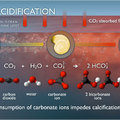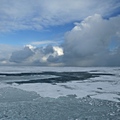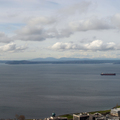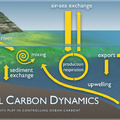Research along the West Coast
The interplay of upwelling and ocean acidification along the U.S. West Coast
The U.S. West Coast is a site of dynamic and intense carbon cycling and may be particularly vulnerable to ocean acidification due to a combination of anthropogenic and natural processes.
Water in the North Pacific is naturally rich in CO2 because the deep water has been out of contact with the atmosphere for a very long time as a result of global ocean circulation patterns. While the water masses travel along the “oceanic conveyer belt,” they accumulate CO2 through natural respiration processes that break down sinking organic matter. Along the U.S. West Coast, winds blow from north to south during spring and summer months, displacing surface water offshore as a result of Earth’s rotation. Deeper water rich in CO2 and nutrients and depleted in O2 upwells to the surface nearshore to replace the displaced surface water.
These characteristics of the upwelling water masses have consequences for both the carbon cycle and ocean acidification along the West Coast. The nutrients in the upwelled water stimulate intense primary production in the nearshore areas where upwelled water reaches the euphotic zone. In addition, upwelling brings water with lower carbonate saturation states and higher acidity to the surface, which may have deleterious consequences for marine organisms. The interplay of ocean acidification and natural carbon cycle processes make the coastal ocean along the U.S. Pacific coastline an interesting and complex region to do research.
PMEL’s Carbon Group actively collaborates with many partners to ensure that high-quality observations of marine carbon are continued and extended along the West Coast and to synthesize the resulting data. Current research is focused on building proxy relationships for predicting or hindcasting ocean acidification conditions using widely measured parameters such as oxygen and temperature (e.g. Juranek et al., 2009); this approach works very well along the Pacific Northwest and Central to Southern California and is being extended to more regions (e.g. North Pacific and Alaskan waters) and to work under hypoxic conditions. Recent research has also revealed the extensive exposure of West Coast ecosystems to acidified conditions, with aragonite undersaturation present along the full western continental shelf and extending to the surface off Northern California during the 2007 upwelling season (Feely et al., 2008). Other recent endeavors include applying a self-organizing map approach to improve air-sea flux estimates along the North American West Coast (Hales et al., in prep.).
References
Feely, R.A., Sabine, C.L., Hernandez-Ayon, J.M., Ianson, D., Hales, B., 2008. Evidence for upwelling of corrosive "acidified" water onto the continental shelf. Science, 320, 1490-1492.
Juranek, L.W., R.A. Feely, W.T. Peterson, S.R. Alin, J. Peterson, K. Lee, C.L. Sabine, and B. Hales, 2009 (in press). Robust determination of aragonite saturation state seasonal evolution near Newport, Oregon using simple algorithms with hydrographic data. Geophysical Research Letters, doi:10.1029/2009GL040778.








